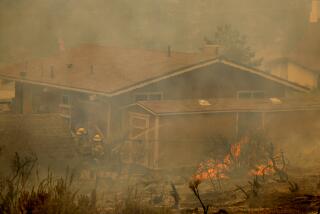Nature replants its own burned forests, environmentalists say
Reporting from JEMEZ SPRINGS, N.M. — During the dry summer of 2011, wind gusts sent a 75-foot aspen tumbling into a power line, sparking a fire on federal land that burned for five weeks over an area the size of Manhattan. All that was left in the hottest burn zones was a silent swath of blackened trees and ash-covered ground.
Federal foresters decided the towering ponderosa pines would never return and declared the area dead, the first step in a process to allow timber companies to harvest trees on public land that would otherwise be off-limits.
But a growing body of fire research indicates that the federal salvage strategy creates more problems than it solves by stunting tree regrowth, denying habitat to a variety of species and increasing the risk of erosion.
Salvage logging destroys the forest’s initial regrowth efforts in nutrient-rich soil and needlessly removes shrubs that are probably beneficial to sapling trees, short-circuiting the natural life cycle of the forest, according to research.
“It’s kicking the forest when it’s down,” said Chad Hanson of the John Muir Project, an environmental nonprofit that opposes salvage logging.
The Forest Service and timber companies say that the dead wood must be removed before the forest can grow and that shrubs have to be killed off with herbicides so the conifers have sun to grow again.
Though part of the Las Conchas fire site was salvage-logged, another section outside New Mexico’s remote Jemez Springs was not.
Four years after the blaze, the Jemez Springs area today is alive with Gambel oak and three-toed woodpeckers, along with occasional conifer saplings growing amid the brush.
“See this?” Hanson said, pulling back a strand of oak to reveal a rubbery green pine sapling just an inch tall. “They said this wouldn’t be here, but we found it. And there’s more.”
By contrast, in places like California’s Rim fire site, salvage crews immediately began felling burned pines and dying trees, spraying the area with herbicide and planting conifer saplings. The result is little ground vegetation but stands of artificially planted conifers returning apace.
Environmentalists and timber industry advocates agree that salvage logging exemplifies the Forest Service’s cornerstone philosophy of ensuring the continued production of wood products on public land.
The Forest Service gets to keep a small share of the profits.
“This is an appropriate and widely accepted process,” Forest Service spokesman John Haynes said in an email. “Our salvage activities are a major part of our active forest management programs.
“As part of these programs, we also allow for reforestation, which includes tree planting and other activities geared toward facilitating new growth.”
Since the 1800s, U.S. forest policy has been to remove dead trees before they fall or burn again, and quickly replant the area, providing new timber.
But that method relies on superficial interpretations of a burned tree, critics say. Hanson, who earned a doctorate in wildfire ecology, instead sees a breeding ground for dozens of species and a future for the forest.
Wood-boring beetles smell smoke and home in on burned trees, a favorite hide-out for them. A species of woodpecker loves burned trees and dines on the wood-boring beetles by pecking a hole in the scorched bark. The holes creates a habitat for a variety of species that would otherwise be shut out of the tree.
Pollinating insects return to the brush, spreading both oak and wildflowers. Bluebirds and other birds return to dine on the bugs. Rodents return to the newly created habitat, and larger predatory species such as the spotted owl return to eat the rodents, referred to half-jokingly by wildfire ecologists as “the bed-and-breakfast effect.” In the Southwest, with enough forest cover, Mexican wolves have returned.
By cutting down dead trees and spraying herbicides, research shows, foresters are undermining this process.
The timber industry and forest economists deride criticism of salvage logging as naive environmentalism.
“Do you want to live in a cement house? Do you want the Canadians to dominate the timber market?” said Bill Stewart, a forest economist at UC Berkeley.
Stewart added that by allowing the burned forests to stand, brush will take over, and the ugly trees will shoo off potential tourists and limit carbon sequestration by hampering regrowth.
But over the last decade, science has turned — emphatically, in some cases — against the strategy.
In a 2006 study in the journal Science, for instance, researchers found that salvage logging destroyed regrowing conifers in Oregon’s 2002 Biscuit fire, while areas that had not been logged showed “abundant” conifer regeneration.
The Forest Service and professors from Oregon State University complained that the study was incomplete and misleading, and called for delaying publication. Science declined.
Since that study, additional research has only served to reinforce that notion. Independent researchers have presented their conclusions to decision-makers in the federal government.
Their conclusions come as the House passed a bill that would expedite post-fire logging. Another bill in the Senate is under consideration.
In a letter to the U.S. Senate, 262 professional scientists, from University of Montana biologists to Texas botanists, protested expediting salvage logging:
“Not only do these legislative proposals misrepresent scientific evidence on the importance of post-fire wildlife habitat and mature forests to the nation, they also ignore the current state of scientific knowledge about how such practices would degrade the ecological integrity of forest ecosystems on federal lands.”
Twitter: @nigelduara
More to Read
Sign up for Essential California
The most important California stories and recommendations in your inbox every morning.
You may occasionally receive promotional content from the Los Angeles Times.










